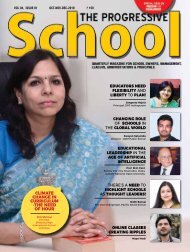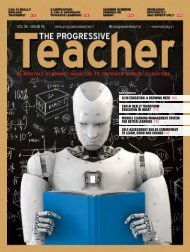The Progressive Teacher Vol 03 Issue 05
This issue of The Progressive Teacher focuses on "Teaching of Social Studies". The magazine provides guidance to the teachers by their peers and school leaders for tackling challenges with innovative ideas.
This issue of The Progressive Teacher focuses on "Teaching of Social Studies". The magazine provides guidance to the teachers by their peers and school leaders for tackling challenges with innovative ideas.
Create successful ePaper yourself
Turn your PDF publications into a flip-book with our unique Google optimized e-Paper software.
Class VI: geography<br />
<strong>The</strong> Earth in the Solar System<br />
Tick ( ) the correct answer<br />
1. How do astronomers learn about stars?<br />
a. Constellations c. Space Walks<br />
b. Telescopes d. Space Stations<br />
2. What is a ‘Light Year’?<br />
a. <strong>The</strong> distance that light travels in one year<br />
b. <strong>The</strong> same as the speed of light<br />
c. <strong>The</strong> amount of time it takes light to travel one mile<br />
d. <strong>The</strong> distance that light travels in one second<br />
3. What is the difference between long-period and<br />
short – period comets? What are the patterns of<br />
stars and the regions of space around them?<br />
a. Long-period comets: more than 100 years. Short –period:<br />
less than 100 years<br />
b. Long-period comets: more than 200 years. Short –period:<br />
less than 200 years<br />
c. Long-period comets: more than 300 years. Short –period:<br />
less than 300 years<br />
d. Long-period comets: more than 500 years. Short –period:<br />
less than 500 years<br />
4. Why are constellations useful?<br />
a. Help in naming stars<br />
b All stars can be seen at the same time<br />
c. Help people to see stars without telescopes<br />
d. Divide the sky into sections and help in the location of a<br />
particular star<br />
5. What is a ‘galaxy’?<br />
a. A large –scale group of planets, stars, moons bound<br />
together by gravity<br />
b. A large-scale group of stars, gas, and dust bound together<br />
by gravity<br />
c. A large-scale group of stars, rocks and dirt bound together<br />
` by gravity<br />
d. A large-scale group of gas, elements and atoms bound<br />
together by gravity<br />
6. What type of galaxy is the ‘Milky Way’?<br />
a. Elliptical c. Irregular<br />
b. Spherical d. Spiral<br />
7. By analysing the light that a star emits ,<br />
astronomers can determine<br />
a. <strong>The</strong> motion of a star<br />
b. Composition and temperature of a star<br />
c. <strong>The</strong> size and weight of a star<br />
d. <strong>The</strong> galaxy that the star belongs to<br />
8. Which inner planets have almost the same size,<br />
mass and density?<br />
a. Mars and Venus c. Mercury and Venus<br />
b. Earth and Mars d. Mercury and Mars<br />
9. Which planets show evidence of heavy volcanic<br />
activity?<br />
a. Mars and Venus c. Venus and Earth<br />
b. Earth and Mars d. Mars and Mercury<br />
worksheet<br />
Max Marks: 20<br />
10. How do the inner planets differ from the outer planets?<br />
a. Outer plants are bigger than inner planets<br />
b. Outer planets have an outer atmosphere and an inner<br />
atmosphere<br />
c. Outer planets are located in the outer zone of the Milky Way<br />
d. Inner planets are smaller, rockier & denser than outer planets<br />
11. <strong>The</strong> Greek astronomer Claudius Ptolemy proposed that<br />
planets moved in small circles, or epicycles, as they<br />
a. Revolved in larger circles around the moon<br />
b. Revolved in larger circles around Sun<br />
c. Revolved in even smaller circles around Earth<br />
d. Revolved in larger circles around Earth<br />
12. <strong>The</strong> Polish astronomer Nicolaus Copernicus<br />
proposed a model for the solar system that was<br />
Sun-centred, or<br />
a. Lunacentric c. Heliocentric<br />
b. Astrocentric d. Celestracentric<br />
13. According to Copernicus, all planets revolved<br />
around<br />
a. <strong>The</strong> Sun in the same direction<br />
b. <strong>The</strong> moon in the same direction but at different speed and<br />
distances<br />
c. <strong>The</strong> Sun in different directions but at the same speed<br />
d. <strong>The</strong> Sun in different directions and speed<br />
14. Upon whose observations did Johannes Kepler<br />
base his three laws of planetary motion?<br />
a. Galileo c. Ptolemy<br />
b. Tycho Brahe d. Newton<br />
15. Compared with terrestrial planets, the gas giants<br />
a. Have more gravity, which helps them retain gases<br />
b. Have less gravity which helps them retain gases<br />
c. Have the same amount of gravity, which helps them retain gases<br />
d. Have no gravity, which helps them retain gases<br />
16. <strong>The</strong> thick atmosphere of the gas giants is made up of<br />
a. Oxygen and Hydrogen c. Hydrogen and Helium<br />
b. Helium and Carbon dioxide d. Carbon dioxide and Oxygen<br />
17. <strong>The</strong> gas giants have ring systems that are made up of<br />
a. Orbiting moons c. Comets<br />
b. Dust and icy debris d. Asteroids and gases<br />
18. <strong>The</strong> composition of asteroids is similar to that of<br />
a. Inner planets c. Comets<br />
b. Gas giants d. Outer planets<br />
19. A comet’s spectacular tail forms when<br />
a. Sunlight changes the comet’s ice to gas<br />
b. Sunlight is reflected from the comet<br />
c. Moonlight is reflected from the comet<br />
d. Gravity pulls gas from the comet<br />
20. What happens when a meteroid enters the Earth’s<br />
atmosphere?<br />
a. Dissolves in the Earth’s atmosphere<br />
b. Gives out heat and light<br />
c. Collides with the Earth<br />
d. Friction between molecules of the atmosphere and the meteroid,<br />
heat up the meteroid’s surface; so most of them burn up<br />
© DS Digital Private Limited I Photocopying permitted <strong>The</strong> <strong>Progressive</strong> <strong>Teacher</strong><br />
27


















